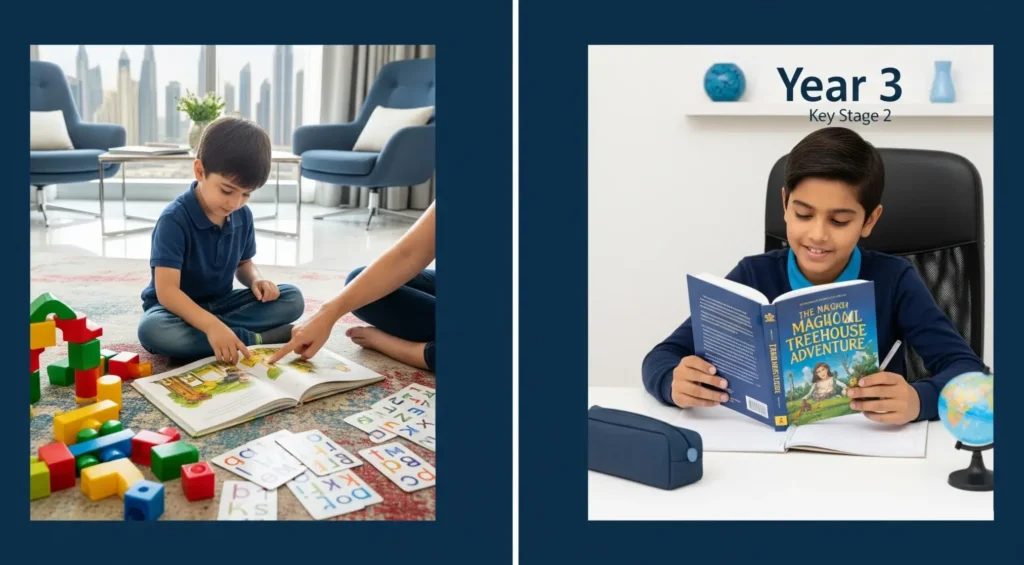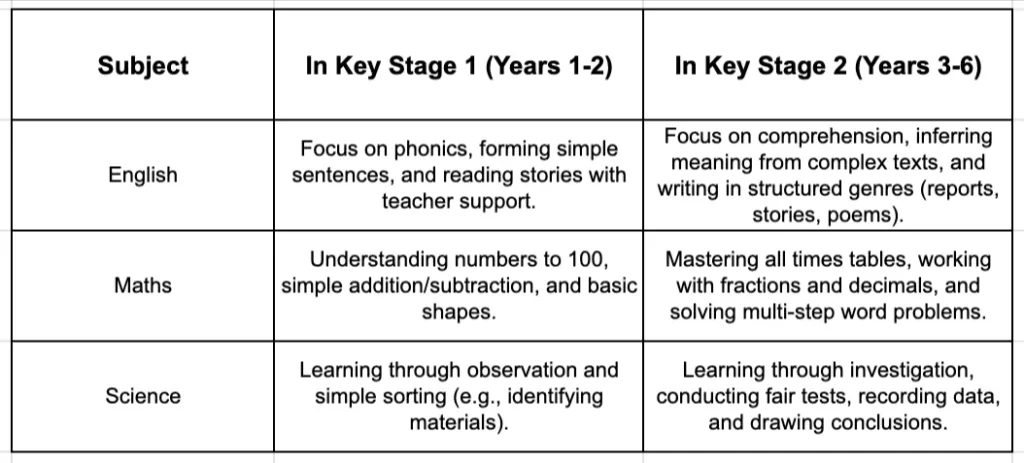Key Stage 1 vs. Key Stage 2: What Parents in Dubai Need to Know
As your child progresses through primary school in Dubai, you’ll become familiar with the milestones of the British curriculum. But of all the transitions they’ll make, the leap from Key Stage 1 (KS1) to Key Stage 2 (KS2) is arguably the most significant.
It’s often a source of quiet concern for parents. You might notice the homework gets harder, the reading books have fewer pictures, and the maths problems suddenly seem a lot more complex.

ou are not imagining it. This transition, which happens as your child moves from Year 2 to Year 3, represents a fundamental shift in academic expectations.
Understanding this leap is key to helping your child navigate it with confidence. This guide will explain the core differences between KS1 and KS2, what to expect in the core subjects, and how you can provide the best support during this crucial stage of their development.
Key Stage 1 (Years 1-2): The World of 'Learning to Read'
Think of KS1 as the foundation-building phase. The primary focus is on equipping children with the fundamental tools of learning in a nurturing and often play-based environment.
The unofficial motto of KS1 is “learning to read.” The educational goal is to master the mechanics of literacy and numeracy.
Literacy: The focus is on phonics—decoding letters and sounds to form words.
Numeracy: The focus is on number sense—understanding what numbers are and mastering basic calculations.
Independence: Children are heavily guided by their teachers, with lots of scaffolding and support.
Key Stage 2 (Years 3-6): The World of 'Reading to Learn'
The transition to KS2 marks a pivot. Now that children have the basic tools, the expectation is that they will start to use those tools to explore the world and learn independently.
The motto of KS2 shifts to “reading to learn.” The focus moves from mechanics to application and critical thinking.
Literacy: Children are now expected to read fluently to gather information from history, geography, and science texts.
Numeracy: The focus shifts to reasoning and applying mathematical concepts to solve multi-step, real-world problems.
Independence: The training wheels come off. Children are expected to take more responsibility for their own learning, manage their time, and conduct their own research.
The Academic Leap: Key Differences at a Glance

This jump, especially in Maths and English, can be a shock to the system for some children. It’s a common point where even previously high-flying students can start to feel overwhelmed. Ensuring your child has a confident grasp of all KS1 concepts is where a primary school tutor in Dubai can provide crucial support, solidifying their foundation before the new challenges begin.
How to Prepare Your Child for the Leap to KS2
Supporting this transition doesn’t mean drilling your child with Year 3 homework over the summer. It’s about nurturing the skills and mindset they’ll need to thrive.
Encourage Reading for Pleasure: The single best thing you can do is foster a love of reading. Move beyond school reading scheme books and explore chapter books, non-fiction, and comics. The more they read for fun, the better equipped they’ll be to read for information in KS2.
Talk About the ‘Why’: Start asking deeper questions. Instead of “What did you learn today?” try “Why do you think that works?” or “What do you think will happen next in the story?” This encourages the kind of critical thinking they’ll need in KS2.
Find the Maths in Everyday Life: Involve them in cooking (fractions), shopping (money calculations), or planning a day out (time). This helps them see maths not as a school subject, but as a practical tool for solving real-world problems.
Foster Independence: Encourage them to pack their own school bag, take responsibility for their homework diary, and work on tasks for short periods without your direct supervision.
Smoothing the Transition with Targeted Support
For some children, the shift to KS2 can reveal small gaps in their foundational knowledge that were not apparent in the more supportive KS1 environment. If you notice your child’s confidence starting to dip or a new reluctance towards homework, it can be a sign that they need to reinforce those core skills. A tutor’s role during this phase is to act as a bridge, ensuring that the foundational skills from KS1 are not just understood, but mastered, providing a smooth and confident entry into the more demanding world of KS2. A little extra help from a dedicated primary English or maths tutor can make all the difference.
Conclusion: A New Chapter of Growth
The leap from KS1 to KS2 is a significant and exciting step in your child’s educational journey. It’s the moment they begin to transform from a guided learner into an independent thinker. By understanding the shift in expectations and fostering the right skills at home, you can turn this potential moment of anxiety into a seamless transition that empowers your child for years to come.
If you feel your child could benefit from personalized support to make the leap to KS2 with confidence, learn more about how our expert primary tutors can help.